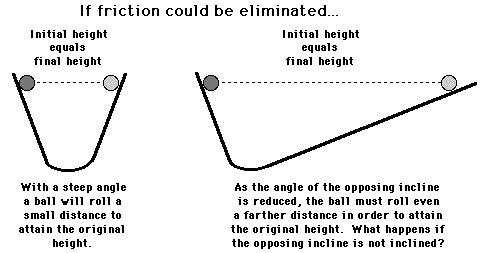Inertia
Inertia, and inertia is the tendency of physical bodies to remain in their state of motion as long as no forces or torques acting on them. A movement that takes place only under the influence of inertia, inertial motion is called. An example of this is the rotation of the earth. The everyday experience, according to yet it requires force to maintain a state of motion is caused by the friction forces.
The measure of the inertia of a body relative to straight-line acceleration is its mass. With respect to the acceleration of the rotary movement, it is its moment of inertia.
- 3.1 Ancient theories of movement
- 3.2 impetus theory
- 3.3 European Renaissance
Importance for important principles of mechanics
The inertia plays an important role in many central principles of mechanics. It is the basis of the principle of inertia, which is an axiom of Newtonian mechanics and thus a basis of classical mechanics. The principle of relativity, which is closely related with the inertia is significant both in classical mechanics, and the basis of the special theory of relativity. The equivalence principle states that inertial mass and gravitational mass are equivalent and is one of the core foundations of the general theory of relativity. The considerations of Ernst Mach to the cause of inertia were used in the development of the general theory of relativity as an important inspiration.
Principle of inertia
The principle of inertia states that a uniformly moving body maintains its uniform motion, especially so a body at rest remains at rest unless a force is exerted on it. A reference system in which the inertia principle is called inertial system. According to Newton 's view, the uniform motion is meant with respect to an absolute space, or due to the Galilean invariance of Newtonian axioms with respect to an inertial frame. Originally, this principle was only for collision processes formulated, since the concept of force, which could have a distance effect did not exist. Newton formulated the principle for the first time in its present form and also agreed with his second axiom, how exactly a force changes the state of motion of a body. Thus, a force causes a proportional acceleration where the proportionality is the inertial mass of the body.
In relativity theory, the principle of inertia is further enhanced by not only the mass but any form of energy behaves sluggish. This allows an analogue of the principle of inertia formulate for the energy of an electromagnetic field. As energy has inertia by the theory of relativity any form of energy has a gravitational effect. For a complete description of gravity and, indirectly, the inertia of the energy -momentum tensor is used, the mass, energy, momentum, pressure and tension of a physical system describes.
Equivalence principle
The inertial mass is a measure of the inertia of a body, which is a measure of how large a force must be to bring about a certain acceleration of a body. A large inertial mass ensures, for example, that a rolling on the flat car is to stop only with great effort. In contrast, the heavy mass is responsible for the extent to which the gravitational force, which affects the body in other body and receives therethrough. In the meantime, has been measured with very high accuracy that these two masses are equivalent, ie can be considered as one and the same size. The assumption that inertial and gravitational mass are exactly the same, ie equivalence principle.
There are in classical mechanics no explanation for the experimentally well confirmed equivalence principle. It was an important basis for Einstein's formulation of general relativity. This theory is formulated so that the equivalence of inertial and gravitational mass follows directly from the formulation, the equivalence principle is therefore a fundamental part of the theory. According to the general theory of relativity, the mass of a body causes space-time curvature and the extended principle of inertia, according to other body now move along the geodesics of the curved space-time, so that the passive gravity of this body is identical to its inertia.
Mach 's Principle
The term "mach cal principle " was coined by Albert Einstein for the philosophical ideas of Ernst Mach, the cause of inertia. Mach assumed that inertia and all related properties of a body would be caused by the other bodies in the universe. As he took up a thought experiment Newton, he put on the presumption that a rotating bucket of water in an otherwise empty universe has no inertia and therefore could also act no centrifugal force on the water so that the water surface would not form a paraboloid of revolution.
Einstein attacked this idea in a more general way, by assuming that the motion of heavy bodies should have an influence on the inertia of other bodies in the vicinity. He therefore looked at the Lense- Thirring effect as confirmation of Mach's views. Today (2009) usual interpretation of this effect summarizes this as a modification of the gravitational field by the rotation on the near and not as a modification of inertia of the body.
Inertial forces
In non- inertial frames occur inertial forces. A seat on a whirligig, for example, through the chain prevented from uniformly moving and forced into a circular orbit. A person on the seat feels a force, the centrifugal force to feel away from the rotational axis of the carousel. An observer which is adjacent to the carousel, is seen that the chains on which the seat is attached to distract the person from a straight trajectory, that is the seat exerts a centripetal force in the direction of the axis of rotation on the person. Both are different ways of looking at the same facts.
In the rotating reference systems, the centrifugal force and the Coriolis force as inertial forces occur during depending occur in other accelerated frames of the acceleration forces of inertia, which usually have no special name.
The inertia was understood by Newton as the inner force that opposes a mass of their acceleration. This force is the sum opposite to the product of mass and acceleration in the inertial frame and this. Since it is the result of an acceleration, not its cause, it is referred to as inertial force or d' Alembert's inertial force.
History
Ancient theories of movement
Prior to the Renaissance in the 15th century in Europe was the theory of motion of Aristotle, in the 3rd century BCE, the this had formulated generally recognized. According to this theory a moving object with no force will slow down and eventually come to rest, so that a constant force is needed to keep an object in motion. Aristotle explained the movement of a thrown object by a force that exerts the surrounding medium on him. Therefore, Aristotle came to the conclusion that such a violent movement in a vacuum is impossible, because no media is present, the keep the body against the resistance of his severity in motion. A body which must be located in non- violent movement in the vacuum on the other hand move forever unaffected.
Despite its success, the general acceptance of Aristotle's doctrine of the movement has been questioned repeatedly by philosophers. Lucretius claimed, for example, the ground state of a body is the movement, not the rest. In the 6th century AD, John Philoponus argued Aristotle's explanation of the non- violent movement in a vacuum would have the effect that a medium abbremse such a body, which is contrary to the thesis that the medium, the motion of a body wished to maintain. He therefore suggested that the movement would not be maintained by the medium, but by a property of the body that would generate if it is set in motion. Averroes and many scholastic philosophers objected to this view and supported the view of Aristotle '. In the Islamic world, however, found Philoponus ' view numerous supporters who further developed his theories.
Impetus theory
In the 14th century, Jean Buridan postulated a movement causing property which he named impetus and assumed that the impetus will not decrease by itself. Instead, he suspected that the air resistance and the weight of a body against WOULD its impetus. Buridan further postulated that the impetus at the speed was increasing; his idea of impetus was thus similar to the modern concept of the pulse. He saw his theory, but only as a modification of Aristotle's philosophy and held on to other teachings of the Peripatetic school. So he went further assume that a fundamental difference between a stationary and a moving body exist. In addition to an ordinary rectilinear impetus he postulated also a Kreisimpetus, which brings about that celestial bodies move in circular orbits.
Buridan's pupil Albert Rickmers village (1316-1390) and a school of philosophy in Oxford continued to pursue the impetus theory and carried out some experiments whose results ' were teaching contrary to Aristotle. Nicholas of Oresme worked the impetus theory further and presented for the first time the laws of motion and correlations of other quantities in graphical form dar.
Shortly before Galileo 's theory of inertia aufstellte, modified Giovanni Battista Benedetti, the impetus theory such that it contained only rectilinear motion. He calls the movement of a stone on a string as an example of a linear movement, which is converted by external pressure in a circular motion. In addition, Benedetti contradicted the first time the doctrine of Aristotle, that objects fall faster, the heavier they are, with a thought experiment: If two falling balls connected to a ( massless ) rod, nothing changes on the rate of fall, although the mass of the whole body increases.
European Renaissance
The law of inertia of the mass dissolved from going back to Aristotle conception according to which to maintain a constant movement force was necessary. The concept of inertia was developed during the 17th century by many physicists.
Thus we find in the writings of Galileo Galilei's first formulation of the related principle of relativity. Galileo's experiments were, however, unsuitable to determine the inertial mass of bodies, since this is compensated in case of experiments by the heavy mass, which is proportional to it. This later established equivalence is called the principle of equivalence. A contemporary and correspondent of Galileo, Giovanni Battista Baliani, but speculated already that the mass independence of the fall times therefore stir that the mass WOULD both as " agens " as well as " passum ", which corresponds to the later introduced concepts of inertial and gravitational mass.
One of the first formulations of the principle of inertia can be found in the Principia Philosophiae of René Descartes. Christiaan Huygens raised the principle of inertia as well as a clear statement of the principle of relativity to axioms that his treatment of collision processes underlie particular.
The initial formulation of the law of inertia in its present form dates back to Isaac Newton, who postulated in his first axiom in 1687:
" A body continues in its state of rest or uniform rectilinear motion, as long as the sum of all forces acting on it is zero. "
Newton saw the source of inertia in a Triple Alliance of absolute mass, time and space and designed the water bucket thought experiment:
In absolutely empty space rotates a bucket of water. The inertial forces now ensures that the water pushes to the edge of the bucket and a parabolic curved surface.
According to Newton's interpretation in this case the absolute space plays a central role. Without it you could not have a circular acceleration ( viewed from the bucket of the whole system is indeed at rest) notice against which the particles buck with their inertia. The space is assumed independent of the rotating bucket as really existing, absolute reference system.
A different approach is pursued Ernst Mach. He suspected that the inertia exerted by all the masses against each other. A single particle in an empty universe would therefore have no inertia. This view has been called, among other things by Albert Einstein as mach cal principle.
Einstein's special theory of relativity was the end of postulated by Newton absoluteness of mass, time and space. In the space-time continuum of special relativity only the space-time distances are absolute. Spatial and temporal distances and inertia are the state of motion dependent. In particular, the inertia grows when approaching the speed of light so fast that it can not be exceeded.
In the Newtonian theory of the equality of inertial and gravitational mass is not explainable "coincidence", as it is postulated in the general theory of relativity as a principle of equivalence. From the equivalence of mass and energy follows that any form of energy has inertia.









